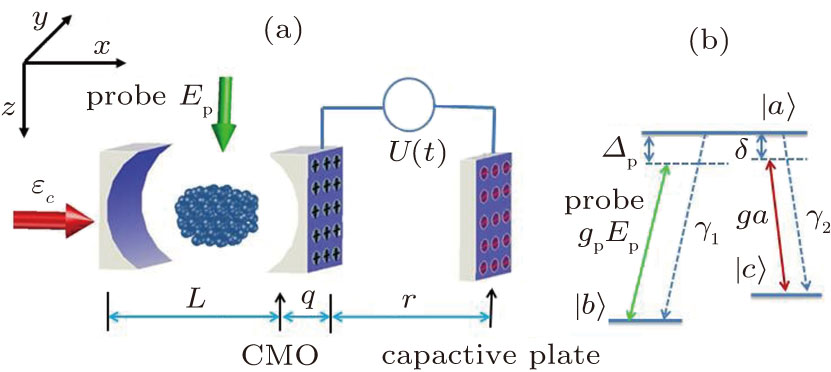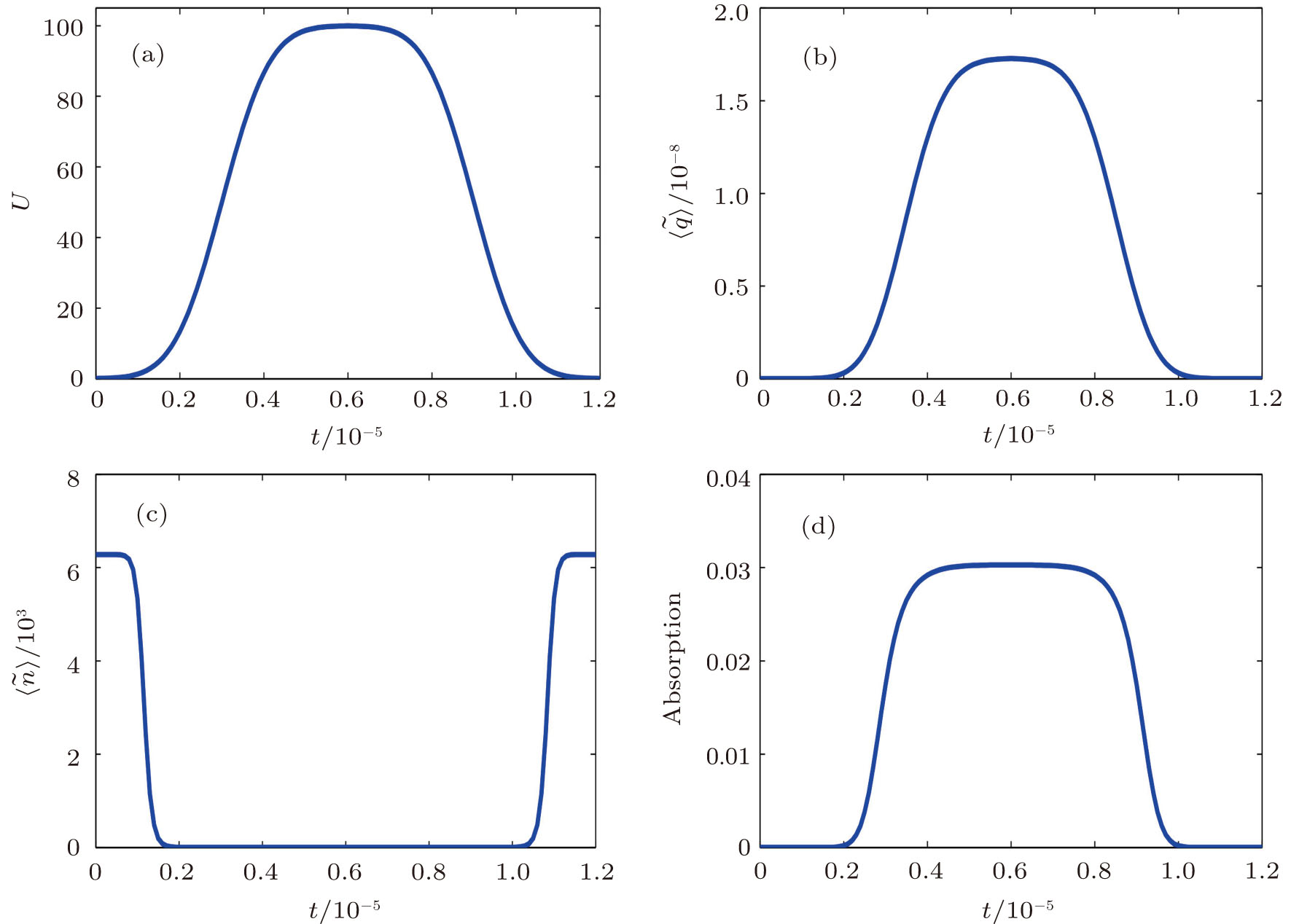† Corresponding author. E-mail:
To promote the future quantum information technologies, we demonstrate an electrically driven optical switch based on quantum interference in a hybrid opto-electromechanical system, which consists of an opto-mechanical cavity and an external electric circuit. The key element of our scheme is a moveable mirror of cavity as a charged mechanical oscillator capacitively coupled to a fixed charged plate in a variable capacitor. By adjusting the voltage of the capacitor, the displacement of the moveable mirror is modulated, then the cavity field can be electrically turned on or off due to the detuning of the cavity. Based on the cavity induced transparency, the transparency window can be electrically switched on or off by turning on or off the cavity field. Therefore, the susceptibility of the medium in the cavity can be electrically controlled, i.e., the scheme of the electrically controlled absorption switching can be demonstrated. This electrically driven optical switch will excite a development trend and implementation prospect towards the integration and miniaturization of quantum module device in a chip.
It has long been appreciated that cavity quantum electrodynamics (QED) has been studied from many different points,[1] especially, quantum coherence effect of a light–matter interaction system in the cavity plays an important role in enhancing and controlling the optical property of the medium. An outstanding instance is cavity induced transparency (CIT),[2] which is an electromagnetically induced transparency (EIT)-like effect. In EIT,[3] when the two metastable states couple to a common excited state by the control and probe fields, the susceptibility of the probe field in the medium is largely modified through the destructive quantum interference of the amplitudes of the two optical transitions.[4] This ability to modify the susceptibility has revealed many new phenomena in quantum optics, such as the optical switch, the storage of light, and quantum memory.[5] CIT effect will occur by replacing the control field with the cavity field when the interactive EIT-medium is trapped inside the optical cavity.
A popular optomechanical cavity consisted of a fixed and a moveable cavity mirrors has been proposed and studied due to its potential applications in high precision measurements and quantum information processing in recent years.[6] In this device, the moveable mirror can be driven by the radiation pressure force from the cavity field as a mechanical resonator (MR).[7–10] Recently, optomechanically induced transparency (OMIT) effect, normal mode splittings, quantum state conversion and pulse transmission have also been observed in such a system.[11–14] The storing optical information has been experimentally demonstrated as a mechanical excitation in a silica optomechanical resonator.[15,16] The crucial component of such an optomechanical system is micomechanical or nanomechanical resonator, which can be efficiently coupled to the different devices as an effective quantum interface. A prototype example is the electromechanical system, in which the MR can be coupled either capacitively or inductively with an electric circuit.[17–19]
Optical switch is a core part of optical networks and information communication technology. An optical switch where a laser pulse controls absorption of another laser field at a different frequency was theoretically proposed by Harris and Yamamoto in a four-level EIT atomic systems based on quantum interference.[20] Then this photon switching was experimentally demonstrated in a four-level 87Rb atomic system.[21] Recently, researchers have reported that a nearly perfect switching of the transmission of the probe field was demonstrated using cavity EIT by applying a weak switching field.[22] Many recent other works on optical switches have been presented, such as optical switches in two-level atom,[23] three-level atom,[24] four-level atom system,[25] all optical switch of vacuum Rabi oscillations,[26] mechanical switch in dual-cavity optomechanical systems,[27] fiber-optical switch controlled by a single atom,[28] etc. These schemes mainly focus on the control of one light field by another.
In this paper, we present an electrically controlled optical switch in a hybrid opto-electromechanical (HOEM) device. This device is made up of the MR of an optomechanical cavity coupled capacitively to a fixed conductive plate in a variable capacitor, hence it involves the advantages of the cavity and the conveniently electrical control. This similar model is attracting the great attention. The interesting phenomena have been presented, such as the entanglement,[29] state transfer,[30] electromagnetically induced absorption,[31] and so on. Recently, we have reported an electrically controlled quantum memories and dark-state polaritons.[32] In this work, a variable capacitor is induced in our model. By changing the voltage on the capacitor, the cavity filed can be modulated to engineer the susceptibility of the medium based on CIT. Here we demonstrate that by sending the different electric voltage pulses on the capacitor, the probe absorption can be switched on or off.
Comparing with the traditionally optical control scheme, our model has the following advantages: (i) The cavity field in the high-Q cavity acts as the control field, the coupling strength between the cavity field and the medium is effectively enhanced. (ii) Based on the CIT, the cavity is turned off or on by changing the voltage on the capacitor. Therefore, the optical switching can be electrically manipulated in the hybrid opto- and electro- mechanical system. (iii) The optical switching can be electrical optimized by the shapes of the voltage waveforms. This capacitive modulation is simple and compact for the integration and application. It is well known that an electrical control is preferable to the optimal control towards the integration and miniaturization. Therefore the adjustment of the optical switch should be improved from the optically to electrically driven ways in order to the practical application.
This paper is organized as follows. In Section
The HOEM system considered in this paper consists of a standard optomechanical cavity and an electric circuit shown in Fig.


In the slowly varying amplitude and weak-field approximations, assuming the most of the atoms are in the collective ground state at all times,[33,34] i.e., 









In the following calculations, we are interested in the steady-state equations. To obtain the steady-state solutions, let us first remove the fast varying factors by the rotating transformations 


From Eq. (
To explore the nonlinear absorption and dispersion of the probe light in our model, let us now study the susceptibility of the atomic medium. The susceptibility of the atomic ensemble to the weak probe field Ep can be described by

It is well known that a technique can be used to make opaque atomic medium transparent by means of quantum interference, i.e., EIT, in which a strong control field that is at resonance with the transition between the metastable and excited state can be used to modify the propagation of a weak light field that couples the ground state to the same excited state in the atomic medium. In such a case, the pathways of two light can interfere and cancel each other. With such destructive quantum interference, the effect that the atoms can not be promoted to the excited states leads to a vanishing light absorption, i.e., the transparent window of the weak probe light without absorption appears by means of the control field. In our model, the cavity field is used to replace the control field in EIT and control the optical absorption of weak probe field in EIT-atomic medium, i.e., CIT. Because of the displacement of CMO governed by the voltage, the strength of the cavity field can be adjusted electrically by the off-resonant loss. Therefore, the voltage can effectively affect the susceptibility of the probe field in the atomic medium based on CIT. To illustrate this effect, figure
 | Fig. 2. (color online) The susceptibility as a function of the probe detuning in the cases of the different voltages. The blue solid (red dashed) line refers to the imaginary (real) part of the susceptibility with (a) U = 0, (b) U = 5, (c) U = 10, (d) U = 100, and the parameters are taken from the experiments in Refs. [36] and [37] as as δ = 0, γ1 = 2π × 2.5 MHz, γ2 = 1 kHz, gp = 0.5 MHz,  |
To reveal the absorptive switching of the probe laser, we give the detail scheme as follows. Firstly an optical field εc is resonantly injected into the cavity without the voltage and interacts with the atomic ensemble, then the population of atomic ensemble is then optically pumped into the ground state |b⟩. The number of photons in the cavity will reach in balance. Afterwards, the weak probe pulse Ep enters the cavity along the z axis and interacts with the atomic medium, as shown in Fig.
We have studied the nonlinear optical properties with the dispersion and absorption of the probe photons in the HOEM system with an optomechanical cavity capacitively coupled an external circuit. A scheme of the absorptive photon switching in the EIT-atomic ensemble trapped inside the HOEM cavity was proposed based on CIT. By the variable capacitance, the cavity field as a control field can be effectively controlled to achieve the adjustment of the transparency window based on CIT mechanism. Therefore, the absorption or non-absorption of the weak probe can be switched on or off by modulating the voltage. The scheme has an advantages: the sensitivity of optical switch can be adjusted by the capacitance with the distance and the area and the width of the voltage waveform. Furthermore, this electrically controlled optical switch is a development trend towards the integration and miniaturization in quantum information processing modules. The scheme proposed here is expected to be applied in the information process and quantum network in the future.
| [1] | |
| [2] | |
| [3] | |
| [4] | |
| [5] | |
| [6] | |
| [7] | |
| [8] | |
| [9] | |
| [10] | |
| [11] | |
| [12] | |
| [13] | |
| [14] | |
| [15] | |
| [16] | |
| [17] | |
| [18] | |
| [19] | |
| [20] | |
| [21] | |
| [22] | |
| [23] | |
| [24] | |
| [25] | |
| [26] | |
| [27] | |
| [28] | |
| [29] | |
| [30] | |
| [31] | |
| [32] | |
| [33] | |
| [34] | |
| [35] | |
| [36] | |
| [37] |



